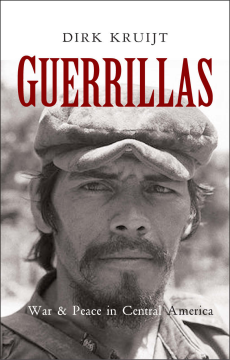
Additional Information
Book Details
Abstract
Three parallel wars were fought in the latter half of the twentieth century in El Salvador, Guatemala and Nicaragua. These wars were long and brutal, dividing international opinion sharply between US support for dictatorial regimes and the USSR’s sponsorship of guerrilla fighters.
This fascinating study of the ‘guerrilla generation’ is based on in-depth interviews with both guerrilla comandantes and political and military leaders of the time. Dirk Kruijt analyses the dreams and achievements, the successes and failures, the utopias and dystopias of an entire Central American generation and its leaders. Guerrillas ranges widely, from the guerrilla movement’s origins in poverty, oppression and exclusion; its tactics in warfare; the ill-fated experiment with Sandinista government in Nicaragua; to the subsequent ‘normalization’ of guerrilla movements within democratic societies. The story told here is vital for understanding contemporary social movements in Latin America.
Dirk Kruijt is Professor of Development Studies in the Faculty of Social Sciences, Utrecht University. For many years he served as a development diplomat and policy advisor in Central America. He has been a visiting professor at several universities in the UK and in Brasil and Mexico, the Andean countries and Central America. His research includes urban poverty, informality and social exclusion; the military and democracy; political conflict and post-war reconstruction in Latin America and the Caribbean. He is co-editor of four previously published Zed titles: Fractured Cities: Social Exclusion, Urban Violence and Contested Spaces in Latin America (2006); Armed Actors: Organised Violence and State Failure in Latin America (2004); Political Armies: The Military and Nation Building in the Age of Democracy (2002); and Societies of Fear: The Legacy of Civil War, Violence and Terror in Latin America (1999).
‘Lucidly written, exceptionally well-informed and admirably honest, this study provides a remarkable portrait of a generation radicalized to the point at which armed struggle was an inevitable duty. Through his interviews with comandantes and regular fighters, Dirk Kruijt has built a vividly illustrated work of contemporary history.‘
James Dunkerley, University of London
'This book helps bring the reader inside the movements and their inspiration in a way that gives a rich insight into the mentalities and motivations that lay behind the resort to arms. As such, it is a major contribution to assessing the legacies of the period and reminds us of the unfinished business that is still pending twenty years later'
Peadar Kirby, University of Limerick
'Uniquely illuminates a 'guerilla generation....radicalized to the point where armed struggle becomes an inescapable duty. Lucid, well-informed and admirably presented.. this is an excellent book'
CHOICE
'A remarkable portrait of a bloody era...exceptionally valuable'
Gavin O'Toole, Latin American Review of Books
'Impeccably researched.'
Tribune
'Dirk Kruijt has crafted this beautiful book out of two decades of concern and deep engagements with Central Americans. With his clear head and unflinching gaze he brings alive both the vicious encounters between governments and revolutionaries that so profoundly affected the lives of Nicaraguans, Guatemalans, and Salvadorans, and the years of aftermath. If I were to choose a first book for some deep learning about the revolutionary guerrilla wars of Central America, this book would be it.'
Timothy P. Wickham-Crowley, Georgetown University
Table of Contents
| Section Title | Page | Action | Price |
|---|---|---|---|
| Contents | v | ||
| Acknowledgements | vii | ||
| Foreword | x | ||
| Abbreviations and Spanish Terms\r | xvii | ||
| Introduction: Guerrillas and Comandantes | 1 | ||
| Terminology | 3 | ||
| Data\r | 6 | ||
| Structure of the Book | 7 | ||
| 1 Dictators and Civil Wars\r | 12 | ||
| Poverty and Exclusion\r | 16 | ||
| Societies of Repression and Fear | 19 | ||
| Chronology of the Guerrilla Wars\r | 30 | ||
| 2 Genesis of a Guerrilla Generation | 39 | ||
| Student Movements | 44 | ||
| Liberation Theology and Base Communities | 47 | ||
| Marxism–Leninism and the Cuban Revolution | 54 | ||
| Splinter Parties and Enduring Loyalties | 59 | ||
| 3 Inside the Guerrilla | 67 | ||
| Guerrilla Strategy in Practice | 68 | ||
| Arms, Financing and Logistics | 82 | ||
| Daily Life and Relations with the Local Population | 88 | ||
| 4 Utopia and Dystopia, Nicaragua | 99 | ||
| Managing the Revolution | 103 | ||
| Alienation, Exclusion and Opposition | 115 | ||
| The Contra War | 119 | ||
| Electoral Defeat | 127 | ||
| 5 Negotiations, Peace and Post-war Reintegration | 133 | ||
| Negotiations and Peace | 135 | ||
| Integration into Society | 149 | ||
| 6 Legacies and Ambivalences\r | 163 | ||
| Legacies | 166 | ||
| Ambivalences | 172 | ||
| Appendices | 179 | ||
| 1 Politico-military Organizations | 179 | ||
| 2 Demographic Data on Central America | 185 | ||
| 3 List of Interviews | 186 | ||
| Notes | 202 | ||
| Foreword | 202 | ||
| Introduction | 202 | ||
| Chapter 1 | 202 | ||
| Chapter 2 | 207 | ||
| Chapter 3 | 210 | ||
| Chapter 4 | 213 | ||
| Chapter 5 | 219 | ||
| Chapter 6 | 222 | ||
| Appendices | 223 | ||
| References | 224 | ||
| Index | 239 |
